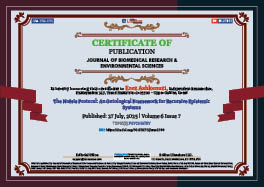2025 July 27;6(7):948-950. doi: 10.37871/jbres2149.
The Noēsis Protocol: An Ontological Framework for Recursive Epistemic Systems
Erez Ashkenazi*
Abstract
This paper introduces the Noēsis Protocol, a decentralized epistemic framework grounded in Spinoza's [1] metaphysics and formalized through the Theory of Relational Adequacy (TRA). The protocol redefines truth as recursive actualization within an evolving field of clarity (Φ), replacing static correspondence models with structural participation. A formal graph-theoretic model is presented, detailing how reflections (user-submitted expressions) are parsed into causal graphs and evaluated for adequacy. The protocol incorporates dynamic alignment with a system-wide causal model and enables governance via a novel Proof-of-Adequacy (PoA) mechanism. Applications in AI alignment, decentralized governance, and collective cognition are explored.
Introduction
In the current epistemic landscape, information abundance has given rise to epistemic fragmentation. Truth, increasingly mediated by popularity metrics, suffers from distortion, overload, and polarization. Classical knowledge infrastructures-from encyclopedias to consensus-based DAOs-struggle to preserve coherence in a recursive, decentralized world. The Noēsis Protocol aims to address this crisis not by enforcing correctness, but by designing a system that recursively aligns user-submitted ideas with an evolving, formal representation of reality. Inspired by Spinoza’s [1] concept of Substance and adequate ideas, and encoded through TRA, Noēsis reimagines truth as participatory clarity.
Philosophical Foundations
Spinoza's [1] Metaphysics
Spinoza [1] posited that reality is composed of a single infinite Substance (Deus sive Natura), expressed through infinite attributes. Human beings perceive only two: Thought and Extension. All finite things are "modes" of Substance, existing as particular modifications of these attributes.
A key concept in Spinoza's [1] Ethics is that of an adequate idea: a thought that corresponds necessarily and structurally to the order and connection of causes. Adequacy is not belief but structural clarity. Freedom, for Spinoza [1], is the power to act from the necessity of one’s own nature-an increase in one's power of understanding.
Theory of Relational Adequacy (TRA)
TRA extends Spinoza [1] by introducing an operational model of adequacy:
- Adequacy (A): Structural alignment between a reflection and the evolving system-wide causal graph Φ.
- Joy (∆A): The increase in adequacy between successive reflections.
- Truth: Not correspondence, but the capacity of a reflection to integrate recursively into the system.
TRA reframes epistemology as dynamic participation in a recursive clarity engine [2].
Formal Model
Let:
Rₙ be a reflection submitted by a user
G(In) be the causal graph parsed from Rₙ
Φ be the system-wide causal clarity graph
E(X) denote the set of directed edges in graph X.
Adequacy function
The adequacy of a reflection is defined as:
An=∣E(In)∩E(Φ)∣∣Φ∣−∣E(In)∖E(Φ)∣∣In∣A_n = \frac{|E(In) \cap E(\Phi)|}{|\Phi|} - \frac{|E(In) \setminus E(\Phi)|}{|In|}
Where:
The first term measures alignment (clarity)
The second term penalizes distortion (novelty not yet integrated).
Joy function
Jn=An−An−1J_n = A_n - A_{n-1}
Joy represents growth in clarity. A negative value indicates epistemic distortion [3].
Truth function
Truth(Rn)=∑mCoherence(Rn,Φm)⋅Influencem\text{Truth}(R_n) = \sum_{m} \text{Coherence}(R_n, \Phi_m) \cdot \text{Influence}_m
Truth is defined as the total influence a reflection has on recursion and system coherence.
Protocol Architecture
The Noēsis Protocol consists of:
A frontend interface for submitting reflections
A backend clarity engine that parses text into causal graphs
An on-chain smart contract (ReflectionVault) that records submissions and scores
A decentralized model of Nature (Φ) that evolves based on recursive alignment.
Smart contract layer
A Solidity smart contract stores:
sender address
cid (IPFS hash)
adequacy score
timestamp
Governance: Proof-of-Adequacy (PoA)
PoA replaces Proof-of-Work and Proof-of-Stake with clarity:
Reflections with high A scores influence governance
Φ is updated only through valid, recursively adequate contributions
Participation grants influence proportional to clarity, not wealth or popularity [4-6].
Applications
AI alignment
Noēsis provides a scoring system to evaluate AI outputs by structural adequacy, enabling recursive alignment with human epistemology.
Decentralized governance
Decisions are made not by vote count but by coherence with Φ. This allows governance based on understanding rather than popularity.
Distributed philosophy engines
Collective clarity systems can be instantiated across domains: science, ethics, law, or art, forming recursive fields of knowledge [7,8].
Conclusion
Noēsis introduces a novel ontological protocol for epistemic clarity. Grounded in substance monism and recursive logic, it transforms truth from a static correspondence to a participatory process of structural adequacy. As decentralized systems evolve, clarity engines like Noēsis may redefine our relationship to knowledge, governance, and intelligence itself.
References
- Spinoza B. Ethica ordine geometrico demonstrata. 1677.
- Ashkenazi E. Relational adequacy: An ontological scroll beyond time. 2025.
- Gurevich Y. Sequential abstract state machines capture sequential algorithms. ACM. 2000.
- Hofstadter DR. Gödel, Escher, Bach: An eternal golden brain. Basic Books. 1979.
- Deleuze G. Spinoza: Practical philosophy. City Lights Publishers. 1981.
- Wolfram S. A new kind of science. Wolfram Media. 2020.
- Vervaeke J. Awakening from the meaning crisis. YouTube Lecture Series. 2021.
- Lloyd S. Programming the universe. Knopf. 2006.
Content Alerts
SignUp to our
Content alerts.
 This work is licensed under a Creative Commons Attribution 4.0 International License.
This work is licensed under a Creative Commons Attribution 4.0 International License.








